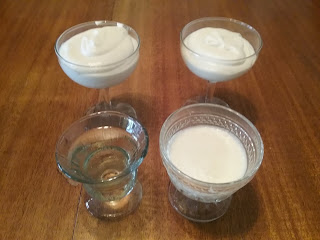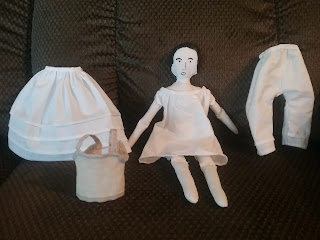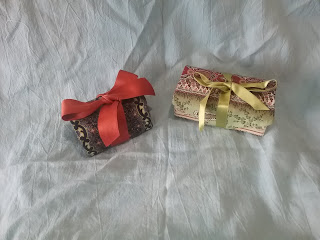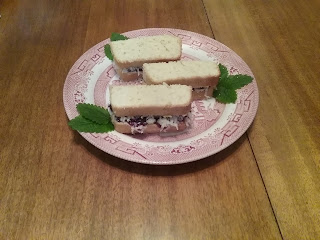A week late, because 2020 runs on its own time...
The Challenge: What's In a Name? Pick a food with a fun name--person, place, thing, or just something fun to say.
The Recipe: A Very Fine Whip from Mrs. Putnam's Receipt Book and Young Housekeeper's Assistant
A VERY FINE WHIP A pound of sugar, half a pint of wine, the juice of four lemons; mix all together, add a quart of rich cream, whip it to a strong froth, and serve in glasses.
The Date/Year and Region: 1849, Boston
How Did You Make It: Twice on a quarter scale (I wanted to experiment with wines, and so divided the half batch into halves).
The first batch, I mixed together 4 oz granulated sugar (~1/2 cup), the juice of 1 (large) lemon, 1/2 cup wine, and 1 cup of whipping cream. After 20 minutes of beating on high, it had barely thickened. The liquid also tasted very strongly of lemon (more so than wine or cream), so I suspected that I'd used too large of a lemon.
The second batch was made identical to the first, except that only 1/2 lemon was used. It solidified in less than 3 minutes. I then spooned it into cups to serve.
I assumed a sweet white wine, as the receipt didn't say. To experiment, I used the sweetest and least sweet white wines I had on hand: the first batch a used a gewürztraminer and in the second a moscato.
Time to Complete: About 10 minutes when it worked.
Total Cost: For this (total) half-batch, about $7. Cream and lemons can get pricey depending on season, and the wine's highly variable.
How Successful Was It?: With the right amount of lemon, it came together very nicely. It's not too sweet but it's sweet enough and very rich. The lemon came through, the wine itself no so much; in fairness, the moscato I used has a really light flavor, so it's possible a different wine would come through more (the gewürztraminer didn't either, but it was buried under way too much lemon).
The successful quarter-batch made 4 very generous servings, I think it would go best spread among 6-8 servings. It's great for a few bites, but I definitely wanted water and something salty before I was half-way through. I tried added some cherry preserves (a serving suggestion) and found they went nice with the whip, but weren't enough on their own to balance it out.
I expect I'll make these again, and most likely with the preserves as suggested, but only in a setting in which I have six or more guests and am serving a variety of foods. Period dinner parties, Candlelight Tour, the collation of historic dishes that happens at my Twelfth Night parties...
How Accurate Is It?: Lemon size concerns aside, I'd rate this fair to moderate in its execution. I used the electric mixer, and was guessing on the wine varietals, but I think I followed the receipt's specifications as far as they were given. I'd normally use heavy whipping cream for any receipt of this sort, but used regular whipping cream, as the store had very limited options.
 |
| Two great whips, one sad not-whip, and a glass of wine. |
















